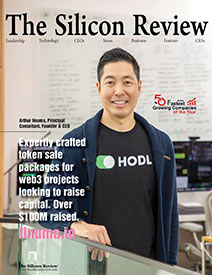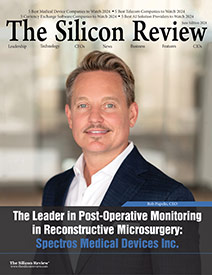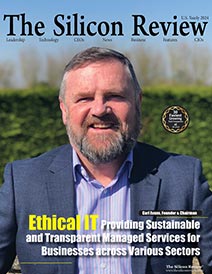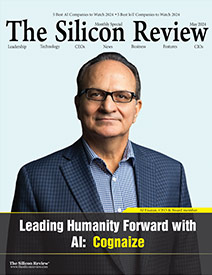50 Innovative Companies to Watch 2020
Drive innovations and stay ahead of the curve by leveraging services from one the leading providers: CPQi Group
The Silicon Review
![]()
Managed services is not an alien invention. Managed services providers (MSPs) started creating an impact in the late 90s. They have continued to play an important role in the way organizations monitor their platforms, manage mobile systems, and secure critical business information. MSPs are positioned uniquely to give advice and support to companies that are moving towards digital transformation, ensuring customers can navigate through the process, work better, and connect more seamlessly. In the digital world that we live in, organizations are not on a single unified platform that can be upgraded. To succeed in their respective forte, businesses have to manage, monitor and optimize this multi-vendor environment. MSPs ensure that all the necessary guidance and required solutions are in place to drive digital transformation.
With a focus on digital transformation, predictive artificial intelligence, DevOps, cloud migration, and omnichannel strategies and development, CPQi Group provides managed services, including building, implementing, & supporting financial markets systems for leading American economies. The company’s services include implementing regulatory changes for financial businesses; this includes upcoming changes such as IBOR and FRTB. CPQi Group was founded in 2006, and it’s headquarters are in Toronto, Canada.
In conversation with Terry Boyland, CEO of CPQi Group
Q. Tell us about the scalability of your cloud infrastructure.
Our cloud infrastructure relies on elastic capabilities leveraging platform services instead of IaaS, where applicable, vertical and horizontal scales (up and down) in response to monitored usage metrics in a distributed architecture, considering CAP theorem based on service/product criticality.
Q. How do you leverage new technologies to update your solutions?
Starting from a product and data-driven approach where requirements such as flexibility, scalability, multi-tenancy, responsiveness, etc. are identified, we define an incremental (e.g., per domain) strategy to leverage loose coupling architecture technologies (e.g., microservices, functions, event-driven, etc.) for applications/platforms modernization. Adopting SAFe and DevOps continuous innovation, our process framework has steps for innovation that go into portfolio analysis and prioritization to implement new technologies into our structure.
Q. Although most enterprises have adopted some form of DevOps, many of them have had trouble scaling it. How do you help organizations to adopt and scale DevOps successfully?
Enabling development and operations architecture capabilities (practices and tools) focusing on full automation, quality and recoverability; organizing deliver on a product/value stream orientation with shared (business) objectives; and creating DevOps advocate structure/teams to disseminate culture, capabilities, feedback architecture, and establish governance/guardrails for flexible and empowered delivery teams. Our framework is based on SAFe to scale lean agile and DevOps practices. We also have CoEs for several areas that support DevOps implementation at scale using DOJO´s and other approaches.
Q. Although banking institutions make their 100% effort to keep the data safe, it becomes hard to protect everything from cybercrime. How do you help your clients fight the severity of cyberattacks?
By considering security as a “by-design” requirement to create infrastructure and application architectures and integrate security throughout the entire delivery lifecycle (security requirements as part of the backlog, secure development, dependency checks, static and dynamic security tests, etc.), release process, and operations (with robust monitoring and response to attacks) on a collaborative approach with security teams. On average, for every 100 developers, there is one security engineer. Using the DevSecOps approach, the developers have security incorporated in their practices, code, and automation pipeline. With this approach, security is injected early in the process and at scale. Other practices include adding security assessments in post-mortem ceremonies, telemetry for environments and application, and protecting the implementation pipeline.
Q. To enable successful business transformation, internal operations of a business/organization should be flawless and streamlined. Do you help companies patch their internal inefficiencies?
Rather than using the traditional method of project management, we help our clients build squads and sprints into their processes. Squads include a focused business person called the Product Owner and can typically be between five and twelve people depending on their size. Several squads are deployed in the same organization, and using agile methods with microservices on the cloud; they can develop multiple parts of the same system without conflicting with each other. A squad receives a user story and is responsible for deploying that story into production. Their combined skill set provides all that is needed for the delivery. Sprints are short bursts of development, usually in about 2 – 3-week cycles, where squads deliver user stories into production. By using this method of development, companies work seamlessly and efficiently on different projects towards one goal.
Q. Do you have any new services launching soon?
Digital Transformation is the key service required by financial institutions today as they seek to provide a frictionless service to their clients and across the internal departments of their own organization. It is important to understand that Digital Transformation is: Cloud, DevOps, Predictive technologies, and Channels.
Breaking that down one further layer to DevOps, this entails Microservices, Cloud Migration, Continuous integration/Deployment, and Building to test. Finally, at the bottom layer, the delivery of requirements and code is now best done using distributed agile methods. These require people working in the same time zone to provide a pipeline of user stories to multiple squads that deliver within suitable timeboxed sprints. This three-layer model addresses the needs of the current market and will take some considerable time to be implemented by large organizations. Beyond that, getting the model to a mature stage requires considerable practitioner experience. CPQi feels that our offering covers the market for the foreseeable future in terms of the services we offer. Within each service, considerable innovation is undertaken to support current market needs as well as ensure our clients can deliver to their customers in a cost-efficient and risk manageable way.
Meet the leader behind the success of CPQi Group
Terry Boyland is the CEO of CPQi Group. With over twenty-five years of senior experience, Terry is one of the leading names in the Americas for the investment banking, Digital Transformation and technology industries. Prior to establishing CPQi 14 years ago, Terry was a member of the Operating Committee and Technology council for JP Morgan with responsibility for Technology across Europe and Asia. During his career he has delivered over £500 million in banking projects with positive EVA and served as a senior adviser to several companies as well as to the Brazilian government. A regular speaker and writer, he has appeared in conference for The Economist, Financial Times, AITEC and the DTI. He has had articles published in The Banker and The FT along with other journals. He is a member of the Brazilian American Chamber of Commerce, a board member of the Brazilian Canadian Chamber of Commerce, Mensa and The Forbes Technology Council. Terry speaks fluent English and Portuguese, lives in Toronto and travels extensively throughout the American continent.









